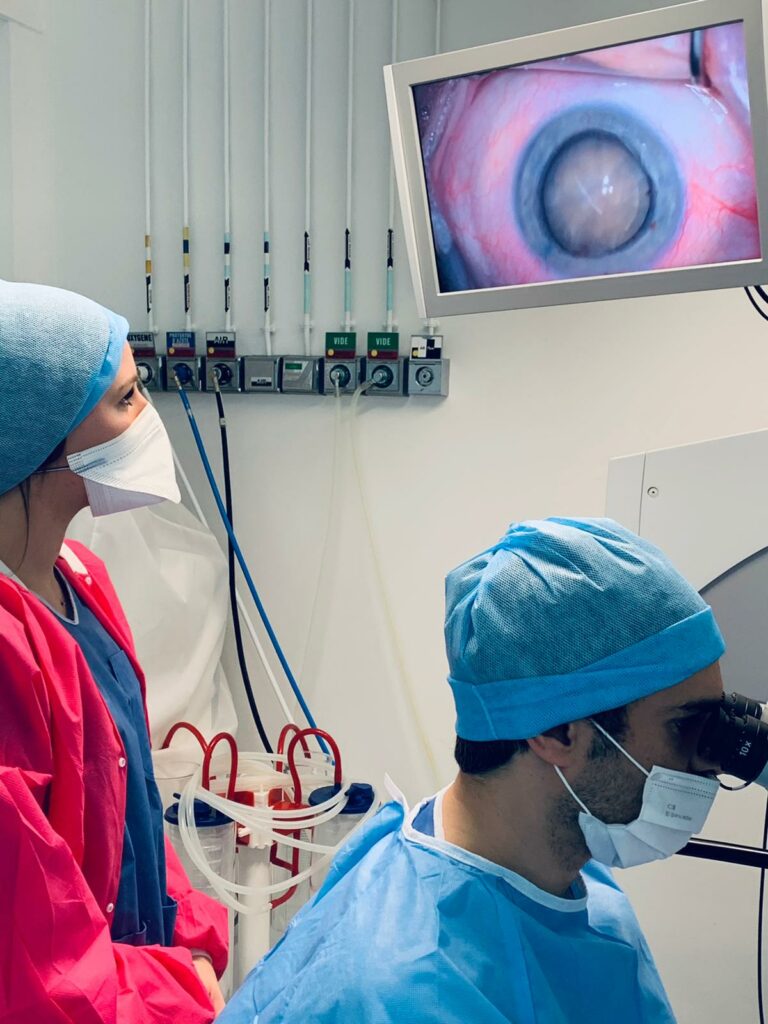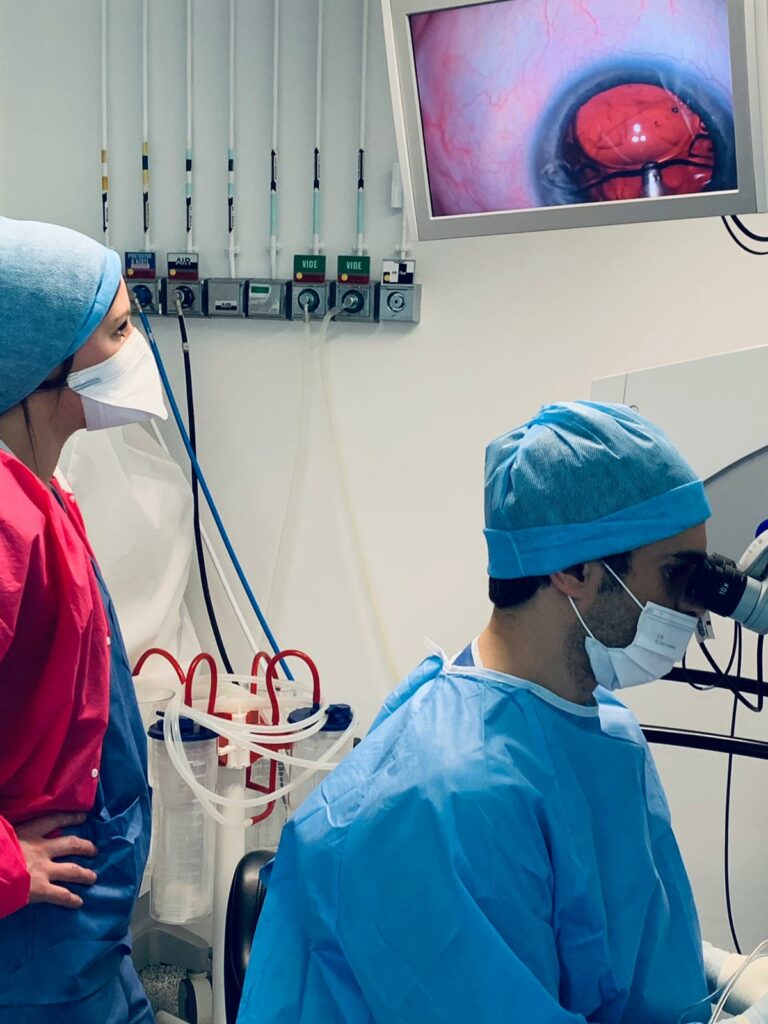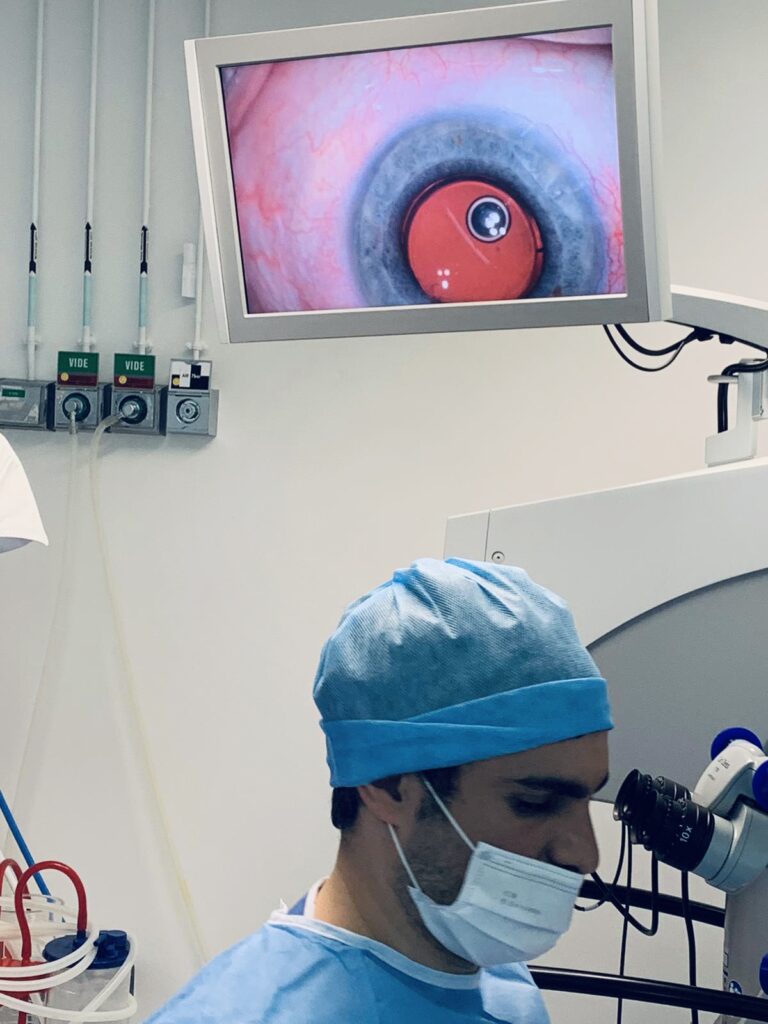
The importance of being screened for glaucoma


Mme H. 55 ans opérée le lundi 22/02/2021
Acuité visuel avant intervention: vision d’ombres à 3 mètres
Avant intervention: Cataracte dense

Injection de l’implant plié par une micro incision de 2mm, se déplie ensuite parfaitement dans le sac capsulaire

Bon positionnement de l’implant

Aspect après quelques minutes d’intervention

Strabismus is characterised by the fact that the eyes (one or both) can turn inwards, outwards, upwards or downwards. It is also known as ‘wandering eye’ or ‘strabismus’.
Children over the age of six months can have a common form of squint that comes and goes. This type of squint may be normal but requires an ophthalmological examination.
Some children are born with strabismus, but it can also be the result ofpoor muscle strength in the eyes.
Signs and symptoms of strabismus can include a child with squinty eyes, an inability to judge distance and pick up objects correctly, closing one eye to see better or dizziness.
Early diagnosis of the underlying problem is essential to prevent vision loss. Strabismus can be treated in a number of ways: masking the stronger eye to increase vision and encourage development of the weaker eye, wearing glasses, eye drops, surgery to straighten the eyes, or eye ‘gymnastics’ exercises.
Presbyopia is a development that can be explained by the increasing difficulty or inability to see things up close as a person ages.
Suddenly, you can only read the newspaper or restaurant menus by holding them at arm's length, at the cost of effort and eye strain.
The eye'scrystalline lens is a kind of lens that enables us to focus and bring objects into image focus. Unfortunately, from the age of 40 onwards, the crystalline lens loses its flexibility and no longer bulges sufficiently to bring objects into focus.
The eye no longer perceives close-up objects clearly and accurately. Images are blurred. The near image is formed at the back of the retina. The result is increasing difficulty in seeing up close.
The astigmatic sees objects distorted since light rays are only partially focused on the retina, only part of the image is projected onto it. Astigmatism may be isolated or associated with myopia or hyperopia.
Astigmatism is corrected by flattening the most cambered cornea, and/or cambering the flattest part, in order to obtain a perfectly round cornea.
It can begin in childhood or adulthood and can easily be corrected if it is the cause of the sight problems. Some signs and symptoms of astigmatism can be headaches, eye strain, difficulty reading and fatigue.
Depending on the severity, glasses or contact lenses may be necessary. Laser refractive surgery can correct astigmatism up to 5 dioptres.
Hypermetropia is often characterised by an eye that is too ‘short’. Vision is blurrier up close than at a distance.
Present at a very early age, it sometimes corrects itself spontaneously as the child grows.
If it persists into adulthood, the cornea can be made more curved by laser correction of hyperopia.
Hyperopia can be corrected with glasses, lenses or refractive surgery which moves the projection of the image on the retina forward in order to get a sharp view.
There are multiple signs and symptoms, including: permanent Strabismus or only when the child is tired which leads to eye rubbing, lack of interest in school with handwriting leaning over the table, the child holds books too close to their face leading to nausea after reading.
The consequence of a chalazion is inflammation caused by the blockage of the drainage duct of a Meibomian gland, located inside the upper and/or lower eyelid.
This then manifests as a small bump on the eyelid, which can grow in size and may become red, painful, with a sensation of heat over the course of several days.

Typically, a chalazion disappears after a few weeks, and in this case, there are no medical consequences. A chalazion is not contagious.
Stye and chalazion
Even though a stye is also a bump in the eyelid caused by the obstruction of a sebaceous gland, a chalazion is not a stye. A stye represents an acute infection of the gland. A chalazion is not an infection but rather an inflammation of the area. Inflammation is a process in which the body reacts to a condition and produces swelling, redness, pain, or heat. A stye is usually more painful than a chalazion and may appear infected.
A chalazion is caused by the oil from the Meibomian gland becoming too thick to flow out of the gland. The oil then accumulates within the gland, forming a bump in the eyelid. The gland's wall may rupture, releasing the oil into the tissue of the eyelid, which then causes inflammation of the tissues and sometimes even scarring.
Medical Treatment
The treatment for a chalazion may include the following:
Applying warm compresses for five to ten minutes, four times a day, to reduce swelling and encourage drainage of the gland.
A medical prescription for antibiotic drops or ointments if a bacterial infection is suspected.
Rarely, an injection of a steroid medication into the area of the bump (the chalazion) to help reduce inflammation.
If a chalazion causes significant symptoms or lasts for several weeks, it may be necessary to remove it surgically. If the appearance of the chalazion bothers the patient, surgical removal may also be performed.
In the case of multiple chalazia or recurrent chalazia, the possibility that the patient may have a generalized condition affecting the sebaceous glands should be considered. This is the case with rosacea: this condition can be treated long-term with oral medication to alter the consistency of the oils produced by the glands.
Amblyopia is characterised by a decrease in vision that occurs in an anatomically healthy eye, but which has not been able to send good visual stimuli to the brain.
It is generally preventable if the underlying cause is treated before the age of six.